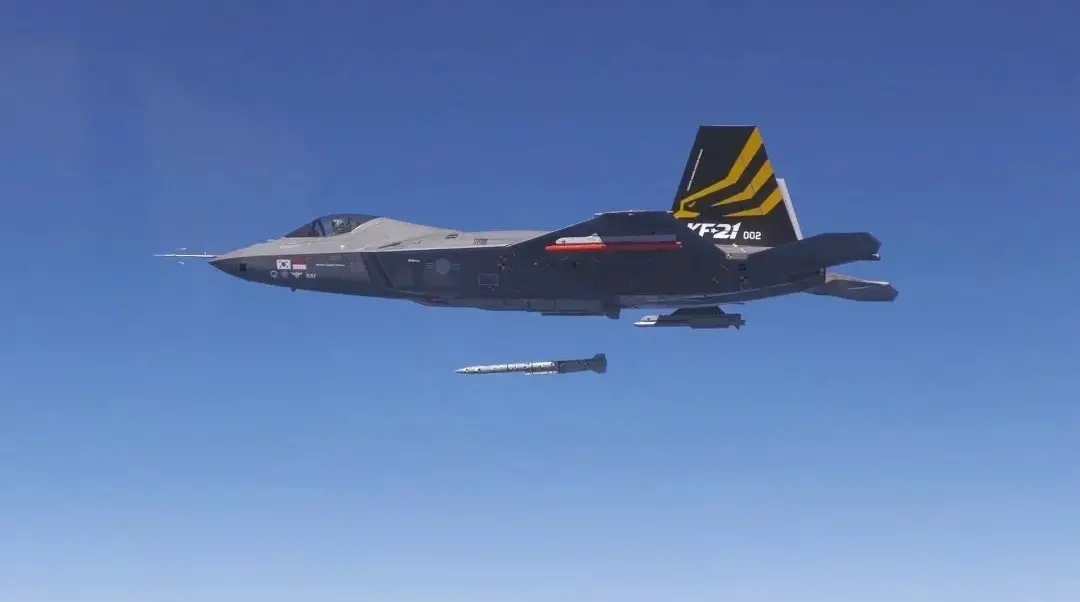South Korea’s homegrown fighter jet KF-21 under development is set to conduct its first live-fire test with long-range air-to-air Meteor missiles this week. The South Korean news agency, Yonhap, reported that A prototype of the KF-21 is scheduled to conduct the test over the waters off the country’s southern coast Wednesday. In March 2023, two prototype aircraft succeeded in separating the Meteor test missiles in midair. If the test is successfully conducted, it is expected to extend the KF-21’s long-range and demonstrate interception capabilities. They equip the Swedish Air Force’s JAS 39 Gripens, the French Air Force and the Navy’s Dassault Rafale, and the Eurofighter Typhoons of the Royal Air Force, German Air Force, Italian Air Force and Spanish Air Force. The Meteor is also intended to equip British and Italian F-35 Lightning IIs, and has been exported to various customers of the Rafale, Typhoon and Gripen.

The Meteor is a European active radar guided beyond-visual-range air-to-air missile (BVRAAM) developed and manufactured by MBDA. It offers a multi-shot capability (multiple launches against multiple targets), and has the ability to engage highly maneuverable targets such as jet aircraft, and small targets such as UAVs and cruise missiles in a heavy electronic countermeasures (ECM) environment with a range far in excess of 200 kilometres (110 nmi). A solid-fueled ramjet motor allows the missile to cruise at a speed of over Mach 4 and provides the missile with thrust and mid-course acceleration. A two-way data link enables the launch aircraft to provide mid-course target updates or retargeting if required, including data from other parties. The data link can transmit missile information such as functional and kinematic status, information about multiple targets, and notification of target acquisition by the seeker.

The KAI KF-21 Boramae (formerly known as KF-X) is a South Korean-led fighter aircraft development program with the goal of producing an advanced multirole fighter for the South Korean and Indonesian air forces. The airframe is stealthier than any fourth-generation fighter, but at present, it does not have internal bays like fifth-generation fighters. Internal bays may be introduced later in development. The program is led by the South Korean government, which holds 60% of the program’s shares. Indonesia took a 20% stake in the program in 2010 and participate the program through Indonesian Aerospace. At least 40 aircraft are planned to be delivered by 2028, with South Korea expecting to deploy 120 of the aircraft by 2032. It will also be available for export market. The KAI KF-X is South Korea’s second domestic fighter jet development program, following the FA-50.

The initial goal for the program was to develop a single-seat twin-engine multirole fighter with stealth capabilities exceeding both the Dassault Rafale and Eurofighter Typhoon but less than those of the Lockheed Martin F-35 Lightning II. The Weapon Systems Concept Development and Application Research Center of Konkuk University advised that the KF-X should be superior to the F-16 Fighting Falcon, with 50% greater combat range, 34% longer airframe lifespan, better avionics, active electronically scanned array (AESA) radar, more-effective electronic warfare, and data link capabilities. Their recommendations specified approximately 50,000 pounds-force (220,000 N) of thrust from two engines, supersonic interception and cruising capabilities, and multi-role capabilities. The project requirements were later downgraded by the Republic of Korea Air Force (ROKAF) to a 4.5 generation fighter with limited stealth capabilities.















